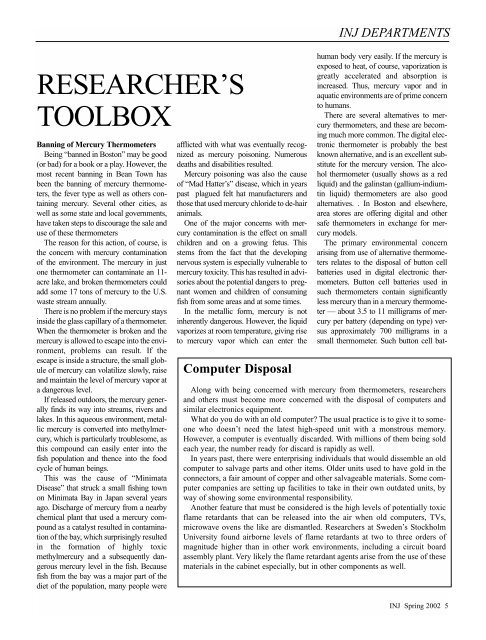2002 - Volume 1 - JEFF. Journal of Engineered Fibers and Fabrics
2002 - Volume 1 - JEFF. Journal of Engineered Fibers and Fabrics
2002 - Volume 1 - JEFF. Journal of Engineered Fibers and Fabrics
You also want an ePaper? Increase the reach of your titles
YUMPU automatically turns print PDFs into web optimized ePapers that Google loves.
RESEARCHER’S<br />
TOOLBOX<br />
Banning <strong>of</strong> Mercury Thermometers<br />
Being “banned in Boston” may be good<br />
(or bad) for a book or a play. However, the<br />
most recent banning in Bean Town has<br />
been the banning <strong>of</strong> mercury thermometers,<br />
the fever type as well as others containing<br />
mercury. Several other cities, as<br />
well as some state <strong>and</strong> local governments,<br />
have taken steps to discourage the sale <strong>and</strong><br />
use <strong>of</strong> these thermometers<br />
The reason for this action, <strong>of</strong> course, is<br />
the concern with mercury contamination<br />
<strong>of</strong> the environment. The mercury in just<br />
one thermometer can contaminate an 11acre<br />
lake, <strong>and</strong> broken thermometers could<br />
add some 17 tons <strong>of</strong> mercury to the U.S.<br />
waste stream annually.<br />
There is no problem if the mercury stays<br />
inside the glass capillary <strong>of</strong> a thermometer.<br />
When the thermometer is broken <strong>and</strong> the<br />
mercury is allowed to escape into the environment,<br />
problems can result. If the<br />
escape is inside a structure, the small globule<br />
<strong>of</strong> mercury can volatilize slowly, raise<br />
<strong>and</strong> maintain the level <strong>of</strong> mercury vapor at<br />
a dangerous level.<br />
If released outdoors, the mercury generally<br />
finds its way into streams, rivers <strong>and</strong><br />
lakes. In this aqueous environment, metallic<br />
mercury is converted into methylmercury,<br />
which is particularly troublesome, as<br />
this compound can easily enter into the<br />
fish population <strong>and</strong> thence into the food<br />
cycle <strong>of</strong> human beings.<br />
This was the cause <strong>of</strong> “Minimata<br />
Disease” that struck a small fishing town<br />
on Minimata Bay in Japan several years<br />
ago. Discharge <strong>of</strong> mercury from a nearby<br />
chemical plant that used a mercury compound<br />
as a catalyst resulted in contamination<br />
<strong>of</strong> the bay, which surprisingly resulted<br />
in the formation <strong>of</strong> highly toxic<br />
methylmercury <strong>and</strong> a subsequently dangerous<br />
mercury level in the fish. Because<br />
fish from the bay was a major part <strong>of</strong> the<br />
diet <strong>of</strong> the population, many people were<br />
afflicted with what was eventually recognized<br />
as mercury poisoning. Numerous<br />
deaths <strong>and</strong> disabilities resulted.<br />
Mercury poisoning was also the cause<br />
<strong>of</strong> “Mad Hatter’s” disease, which in years<br />
past plagued felt hat manufacturers <strong>and</strong><br />
those that used mercury chloride to de-hair<br />
animals.<br />
One <strong>of</strong> the major concerns with mercury<br />
contamination is the effect on small<br />
children <strong>and</strong> on a growing fetus. This<br />
stems from the fact that the developing<br />
nervous system is especially vulnerable to<br />
mercury toxicity. This has resulted in advisories<br />
about the potential dangers to pregnant<br />
women <strong>and</strong> children <strong>of</strong> consuming<br />
fish from some areas <strong>and</strong> at some times.<br />
In the metallic form, mercury is not<br />
inherently dangerous. However, the liquid<br />
vaporizes at room temperature, giving rise<br />
to mercury vapor which can enter the<br />
Computer Disposal<br />
INJ DEPARTMENTS<br />
human body very easily. If the mercury is<br />
exposed to heat, <strong>of</strong> course, vaporization is<br />
greatly accelerated <strong>and</strong> absorption is<br />
increased. Thus, mercury vapor <strong>and</strong> in<br />
aquatic environments are <strong>of</strong> prime concern<br />
to humans.<br />
There are several alternatives to mercury<br />
thermometers, <strong>and</strong> these are becoming<br />
much more common. The digital electronic<br />
thermometer is probably the best<br />
known alternative, <strong>and</strong> is an excellent substitute<br />
for the mercury version. The alcohol<br />
thermometer (usually shows as a red<br />
liquid) <strong>and</strong> the galinstan (gallium-indiumtin<br />
liquid) thermometers are also good<br />
alternatives. . In Boston <strong>and</strong> elsewhere,<br />
area stores are <strong>of</strong>fering digital <strong>and</strong> other<br />
safe thermometers in exchange for mercury<br />
models.<br />
The primary environmental concern<br />
arising from use <strong>of</strong> alternative thermometers<br />
relates to the disposal <strong>of</strong> button cell<br />
batteries used in digital electronic thermometers.<br />
Button cell batteries used in<br />
such thermometers contain significantly<br />
less mercury than in a mercury thermometer<br />
— about 3.5 to 11 milligrams <strong>of</strong> mercury<br />
per battery (depending on type) versus<br />
approximately 700 milligrams in a<br />
small thermometer. Such button cell bat-<br />
Along with being concerned with mercury from thermometers, researchers<br />
<strong>and</strong> others must become more concerned with the disposal <strong>of</strong> computers <strong>and</strong><br />
similar electronics equipment.<br />
What do you do with an old computer? The usual practice is to give it to someone<br />
who doesn’t need the latest high-speed unit with a monstrous memory.<br />
However, a computer is eventually discarded. With millions <strong>of</strong> them being sold<br />
each year, the number ready for discard is rapidly as well.<br />
In years past, there were enterprising individuals that would dissemble an old<br />
computer to salvage parts <strong>and</strong> other items. Older units used to have gold in the<br />
connectors, a fair amount <strong>of</strong> copper <strong>and</strong> other salvageable materials. Some computer<br />
companies are setting up facilities to take in their own outdated units, by<br />
way <strong>of</strong> showing some environmental responsibility.<br />
Another feature that must be considered is the high levels <strong>of</strong> potentially toxic<br />
flame retardants that can be released into the air when old computers, TVs,<br />
microwave ovens the like are dismantled. Researchers at Sweden’s Stockholm<br />
University found airborne levels <strong>of</strong> flame retardants at two to three orders <strong>of</strong><br />
magnitude higher than in other work environments, including a circuit board<br />
assembly plant. Very likely the flame retardant agents arise from the use <strong>of</strong> these<br />
materials in the cabinet especially, but in other components as well.<br />
INJ Spring <strong>2002</strong> 5

















